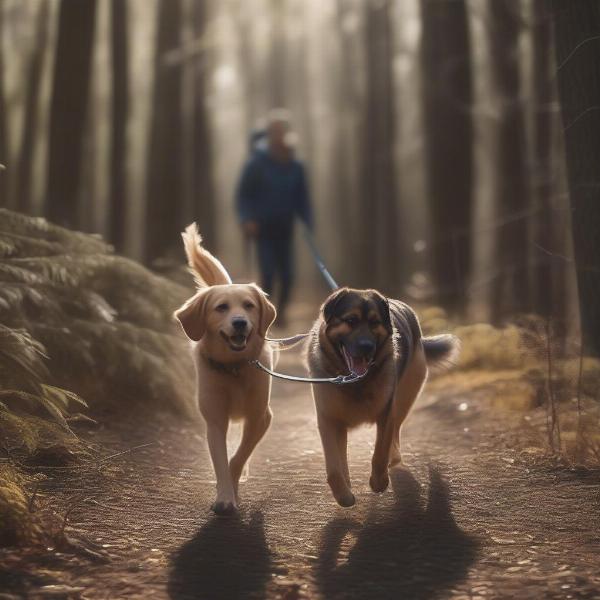Long leads for dog training offer a unique blend of freedom and control, allowing your canine companion to explore while still under your watchful eye. These leads, typically ranging from 10 to 30 feet or even longer, provide a valuable tool for teaching recall, improving loose-lead walking, and building a strong bond between you and your dog. They’re particularly helpful in open spaces where your dog can practice commands without the restrictions of a short leash. Whether you’re working on basic obedience or addressing specific behavioral challenges, understanding the benefits and effective use of a long lead can significantly enhance your training experience.
Choosing the Right Long Lead for Your Dog
Selecting the appropriate long lead depends on several factors, including your dog’s size, breed, and training needs. For smaller breeds, a lighter, thinner lead might suffice, whereas larger, more powerful dogs will benefit from a sturdier, wider option. Consider the material too: Biothane is durable and easy to clean, while nylon is lightweight and affordable. Ultimately, the best long lead is one that is comfortable for both you and your dog and suits the specific training goals you have in mind.
Mastering Recall with a Long Lead
One of the most significant advantages of using a long lead is its ability to facilitate recall training. By allowing your dog some freedom to roam, you can create more realistic scenarios for practicing the “come” command. Start by calling your dog while they are still relatively close and gradually increase the distance as they become more reliable. Remember to use positive reinforcement, such as treats and praise, to reward successful recalls, making the experience enjoyable and encouraging future responsiveness.
Addressing Behavioral Issues with Long Leads
Long leads can be instrumental in addressing specific behavioral issues, such as pulling on the leash or lunging at other dogs or people. The extra length provides a buffer zone, allowing you to redirect your dog’s attention and correct unwanted behaviors without the direct pressure of a short leash. This allows for more effective communication and helps your dog learn appropriate responses in challenging situations.
“Using a long lead allowed me to work with my reactive dog in a more controlled environment,” says certified dog trainer Sarah Miller. “It gave him space to decompress while still allowing me to guide his behavior.”
Beyond Basic Obedience: Advanced Training Techniques
As your dog progresses, long leads can be incorporated into more advanced training scenarios, such as scent work, agility training, and even hunting dog training. The extended range provides opportunities for more complex exercises and challenges, helping your dog refine their skills and build confidence.
 Advanced dog training techniques using a long lead
Advanced dog training techniques using a long lead
Maintaining Safety and Control with Long Leads
While long leads offer increased freedom, it’s crucial to prioritize safety and maintain control. Always be mindful of your surroundings and choose training locations that are free from hazards, such as traffic or other distractions. Learn how to properly manage the lead to prevent tangling and ensure you can quickly reel in your dog if needed.
“Never wrap the lead around your hand,” advises veterinary behaviorist Dr. Emily Carter. “This can cause serious injury if your dog suddenly bolts.”
Conclusion: Long Leads for a Stronger Bond
Long leads are a versatile training tool that can benefit dogs of all ages and breeds. From mastering recall to addressing behavioral issues and exploring advanced training techniques, a long lead can empower you to build a stronger bond with your canine companion while fostering their independence and confidence. Choosing the right lead and understanding its effective use can transform your training experience and unlock your dog’s full potential.
FAQ:
-
What is the ideal length for a long lead? Lengths typically range from 10 to 30 feet, but the best length depends on your dog’s individual needs and the training environment.
-
Are long leads suitable for all dogs? Yes, with proper training and supervision.
-
Can I use a long lead for everyday walks? While long leads are great for training, they may not be ideal for all walking situations due to safety and control considerations.
-
What material is best for a long lead? Biothane and nylon are popular choices, each offering unique advantages.
-
How do I prevent my long lead from tangling? Proper handling techniques and choosing a lead with good swivels can help minimize tangles.
-
Can I let my dog off-leash after training with a long lead? Only in designated off-leash areas and if your dog has demonstrated reliable recall.
-
Where can I buy a quality long lead? Reputable pet stores and online retailers offer a wide selection.
ILM Dog is your trusted source for expert advice and resources on all aspects of dog care. We offer comprehensive guides on breed selection, health and wellness, training, nutrition, grooming, and much more. From puppies to senior dogs, we’re committed to helping you provide the best possible care for your beloved companion. For expert advice, contact us at [email protected] or call +44 20-3965-8624. Visit ILM Dog today to discover a world of information and support for all your dog-related needs.